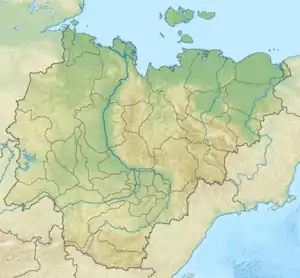Kular Range
The Kular Range (Russian: Кулар хребет, Kular Khrebet; Yakut: Кулар сис, Kular Sis) is a range of mountains in far North-eastern Russia. Administratively the range is part of the Eveno-Bytantaysky National District of the Sakha Republic, Russian Federation.[1]
| Kular Range | |
|---|---|
| Кулар хребет / Кулар сис | |
 Kular Range Location in the Sakha Republic, Russia | |
| Highest point | |
| Peak | Unnamed |
| Elevation | 1,289 m (4,229 ft) |
| Coordinates | 68°54′N 131°53′E |
| Dimensions | |
| Length | 380 km (240 mi) NE / SW |
| Geography | |
| Location | Sakha Republic, Far Eastern Federal District |
| Parent range | Verkhoyansk Range, East Siberian System |
| Geology | |
| Type of rock | Shale, sandstone and Granite intrusions (North) |
This range is one of the places in Yakutia where yedoma are found.[2]
Geography
The Kular Range extends in an arch north of Batagay-Alyta to the NE for about 380 kilometres (240 mi), west and NW of the Bytantay River and west of the Yana, after it joins that great river. In the northeast rise the Kyundyulyun mountains, a prolongation beyond the Yana River. The highest point of the Kular Range is an unnamed 1,289 metres (4,229 ft) high summit.[1]
It is one of the main subranges of the Verkhoyansk Range system. To the west it is limited by the Omoloy River valley, beyond which rises the Sietinden Range, which runs in a parallel direction. The range is deeply cut by wide riverine intermontane basins in its middle part. The Yana-Indigirka Lowland lies to the northeast.
The mountains are covered with mountain tundra and in the valleys with larch forests and tundra.
Ulakhan Sis Range
Near the northern end of the Kular Range, at 70°23′46.2″N 134°22′37.95″E —about 440 kilometres (270 mi) north of the Arctic Circle, there is a branch of the main range running northwards named Ulakhan Sis. It is about 100 kilometres (62 mi) long and its highest point is 496 metres (1,627 ft). The Yana River meanders northwards east of the Ulakhan Sis Range and beyond it rises the Magyl-Tasa Massif.[3]
 Map section showing the Kular Range in the middle and its Ulakhan Sis subrange at the top. |
References
- Kular (mountains) / Great Soviet Encyclopedia; in 35 vols. / Ch. ed. Yu. S. Osipov. 2004—2017.
- Vasil'chuk Y.K., Budantseva N.A., Vasil'chuk J.Y. , Heavy metals and trace elements in the Late Pleistocene ice-wedge casts of Northern Yakutia/ Arctic and Antarctica. – 2017. – № 1. – P. 23
- Google Earth